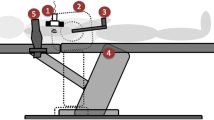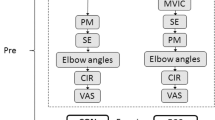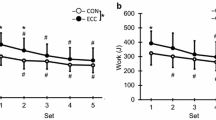Abstract
Purpose
This study investigated changes in electrical pain threshold (EPT) after repeated eccentric exercise bouts to test the hypothesis that fascia would become more sensitive than muscle when greater delayed onset muscle soreness (DOMS) is induced.
Methods
Ten young men performed two eccentric exercise bouts (ECC1, ECC2) consisting of ten sets of six maximal isokinetic eccentric contractions of the elbow flexors with the same arm separated by 4 weeks. Maximal voluntary isometric contraction torque, range of motion, muscle soreness assessed by a visual analogue scale (VAS) and pressure pain threshold (PPT) were measured before, immediately after and 1–5 days after exercise. EPT was assessed in the biceps brachii fascia (BBF), biceps brachii muscle, and brachialis fascia (BF) 1 day before, immediately after, and 1, 2 and 4 days after exercise.
Results
All measures showed smaller changes (P < 0.05) after ECC2 than ECC1. EPT decreased after both bouts and the largest decreases were evident at 2 days post-exercise (P < 0.05). The decreases in EPT after ECC1 were greater (P < 0.05) for both BBF (Baseline: 1.45 ± 0.23 mA, 2 days post-exercise: 0.13 ± 0.11 mA) and BF (1.64 ± 0.29 mA, 0.26 ± 0.2 mA) than muscle (1.56 ± 0.29 mA, 0.69 ± 0.33 mA). Changes in EPT were correlated with the changes in PPT (r = 0.63–0.87, P ≤ 0.05) but not with VAS (r = −0.01 to 0.50).
Conclusion
These results show that fascia becomes more sensitive than muscle to electrical stimulation after the initial eccentric exercise, suggesting that damage inflammation to fascia than muscle fibres is more associated with DOMS.



Similar content being viewed by others
Abbreviations
- ANOVA:
-
Analysis of variance
- BBF:
-
Biceps brachii fascia
- BF:
-
Brachialis fascia
- CV:
-
Coefficient of variation
- DOMS:
-
Delayed onset muscle soreness
- ECC:
-
Eccentric exercise
- EPT:
-
Electrical pain threshold
- MVC:
-
Maximal voluntary contraction
- PPT:
-
Pressure pain threshold
- ROM:
-
Range of motion
- SEMs:
-
Standard error of measurements
- VAS:
-
Visual analogue scale
References
Andres KH, von During M, Schmidt RF (1985) Sensory innervation of the achilles tendon by group III and IV afferent fibers. Anat Embryol (Berl) 172:145–156
Armstrong RB (1984) Mechanisms of exercise-induced delayed onset muscular soreness: a brief review. Med Sci Sports Exerc 16:529–538
Chen TC, Nosaka K, Sacco P (2007) Intensity of eccentric exercise, shift of optimum angle, and the magnitude of repeated-bout effect. J Appl Physiol 102:992–999
Cheung K, Hume PA, Maxwell L (2003) Delayed onset muscle soreness: treatment strategies and performance factors. Sports Med 33:145–164
Crameri RM, Aagaard P, Ovortrup K, Langberg H, Olesen JK (2007) Myofibre damage in human skeletal muscle: effects of electrical stimulation versus voluntary contraction. J Physiol 583:365–380
Deising S, Weinkayf B, Blunk J, Obreja O, Schmelz M, Rukwied R (2012) NGF-evoked sensitization of muscle fascia nocieptors in humans. Pain 153:1673–1679
Gibson W, Arendt-Nielsen L, Graven-Nielsen T (2006) Delayed onset muscle soreness at tendon–bone junction and muscle tissue is associated with facilitated referred pain. Exp Brain Res 174:351–360
Gibson W, Arendt-Nielsen L, Taguchi T, Mizumura K, Graven-Nielsen T (2009) Increased pain from muscle fascia following eccentric exercise: animal and human fingings. Exp Brain Res 194:299–308
Howatson G, van Someren KA (2008) The prevention and treatment of exercise-induced muscle damage. Sports Med 38:483–503
Howatson G, van Someren K, Hortobáguyi T (2007) Repeated bout effect after maximal eccentric exercise. Int J Sports Med 28:557–563
Itoh K, Okada K, Kawakita K (2004) A proposed experimental model of myofascial trigger points in human muscle after slow eccentric exercise. Acupunct Med 22:2–13
Jamurtas AZ, Theocharis V, Tofas T, Yfanti C, Paschalis V, Koutedakis Y, Nosaka K (2005) Comparision between leg and arm eccentric exercises of the same relative intensity on indices of muscle damage. Eur J Appl Physiol 95:179–185
Lau WY, Nosaka K (2011) Effect of vibration treatment on symptoms associated with eccentric exercise-induced muscle damage. Am J Phys Med Rehabil 90:648–657
Lau WY, Muthalib M, Nosaka K (2013) Visual analog scale and pressure pain threshold for delayed onset muscle soreness assessment. J Musculoskelet Pain 21:320–326
Lauritzen F, Paulsen G, Raastad T, Bergersen LB, Owe SG (2009) Gross ultrastructural changes and necrotic fiber segments in elbow flexor muscles after maximal voluntary eccentric action in humans. J Appl Physiol 107:1923–1934
MacIntyre DL, Reid WD, McKenzie DC (1995) Delayed muscle soreness: the inflammatory response to muscle injury and its clinical implications. Sports Med 20:24–40
Malm C, Sjödi B, Sjöberg B, Lenkei R, Renström P, Lundberg IE, Ekblom B (2004) Leuokocytes, cytokines, growth factors and hormnones in human skeletal muscle and blood after uphill or downhill running. J Physiol 556:983–1000
McHugh MP (2003) Recent advances in the understanding of the repeated bout effect: the protective effect against muscle damage from a single bout of eccentric exercise. Scand J Med Sci Sports 13:88–97
Mense S (1993) Nociception from skeletal muscle in relation to clinical muscle pain. Pain 54:241–289
Mense SE, Simons DG (2001) Muscle pain understanding its nature, diagnosis, and treatment. Lippincott Williams & Wilkins, Baltimore, p 29
Millan MJ (1999) The induction of pain: an integrative review. Prog Neurobiol 57:1–164
Murase S, Terazawa E, Queme F, Ota H, Matsuda T, Hirate K, Kozaki Y, Katanosaka K, Taguchi T, Urai H, Mizumura K (2010) Bradykinin and nerve growth factor play pivotal roles in muscular mechanical hyperalgesia after exercise (delayed onset muscle soreness). J Neurosci 30:3752–3761
Murase S, Terazawa E, Hirate K, Yamanaka H, Kanda H, Noguchi K, Ota H, Queme F, Taguchi T, Mizumura K (2013) Upregulated glial cell line-derived neurotrophic factor through cyclooxygenase-2 activation in the muscle is required for mechanical hyperalgesia after exercise in rats. J Physiol 591:3035–3048
Muthalib M, Lee H, Millet GY, Ferrari M, Nosaka K (2012) The repeated-bout effect: influence on biceps brachii oxygenation and myoelectrical activity. J Appl Physiol 110(5):1390–1399
Nosaka K, Newton M, Sacco P, Chapman D, Lavender A (2005) Partial protection against muscle damage by eccentric actions at short muscle lengths. Med Sci Sports Exerc 37:746–753
Ota H, Katanosaka K, Murase S, Kashio M, Tominaga M, Mizumura K (2013) TRPV1 and TRPV4 play pivotal roles in delayed onset muscle soreness. PLoS One. doi:10.1371/journal.pone.0065751
Paulsen G, Lauritzen F, Bayer ML, Kalhovde JM, Ugelstad I, Owe SG, Hallén J, Bergersen LH, Raastad T (2009) Subcellular movement and expression of HSP27, αB-crystallin, and HSP70 after two bouts of eccentric exercise in humans. J Appl Physiol 107:570–582
Paulsen G, Crameri R, Benestad HB, Fjeld JG, Morkrid L, Hallen J, Raasad T (2010) Time course of leukocyte accumulation in human muscle after eccentric exercise. Med Sci Sports Exerc 42:75–85
Proske U (2005) Muscle tenderness from exercise: mechanisms? J Physiol 564:1
Raastad T, Owe SG, Paulsen G, Enns D, Overgaard K, Crameri R, Kill S, Belcastro A, Bergersen L, Hallen J (2010) Changes in calpain activity, muscle structure and function after eccentric exercise. Med Sci Sports Exerc 42:86–95
Stacey MJ (1969) Free nerve endings in skeletal muscle of the cat. J Anat 105:231–254
Stauber WT, Clarkson PM, Fritz VK, Evan WJ (1990) Extracellular matrix disruption and pain after eccentric muscle action. J Appl Physiol 69:93–99
Taguchi T, Sato J, Mizumura K (2005) Augmented mechanical response of muscle thin-fiber sensory receptors recorded from rat muscle-nerve preparations in vitro after eccentric contraction. J Neurophysiol 94:2822–2831
Tesarz J, Hoheisel U, Wiedenhofer B, Mense S (2011) Sensory innervation of the thoracolumbar fascia in rats and humans. Neuroscience 194:302–308
Umbel JD, Hoffman RL, Dearth DJ, Chleboun GS, Manini TM, Clark BC (2009) Delayed-onset muscle soreness induced by low-load blood flow-restricted exercise. Eur J Appl Physiol 107:687–695
Von Düring M, Andres KH (1990) Topography and ultrastructure of group III and IV nerve terminals of cat’s gastrocnemius-soleus muscle. In: Zenker W, Neuhuber WL (eds) The primary afferent neuron: a survey of recent morpho-functional aspects. Plenum, New York
Weerakkody NS, Percival P, Hickey MW, Morgan DL, Greory JE, Canny BJ, Proske U (2003) Effects of local pressure and vibration on muscle pain from eccentric exercise and hypertonic saline. Pain 105:425–435
Yu JG, Carlsson L, Thornell LE (2004) Evidence for myofibril remodeling as opposed to myofibril damage in human muscles with DOMS: an ultrastructural and immunoelectron microscopic study. Histochem Cell Biol 121:219–227
Conflict of interest
The authors declare that we have no conflict of interest.
Author information
Authors and Affiliations
Corresponding author
Additional information
Communicated by Toshio Moritani.
Rights and permissions
About this article
Cite this article
Lau, W.Y., Blazevich, A.J., Newton, M.J. et al. Changes in electrical pain threshold of fascia and muscle after initial and secondary bouts of elbow flexor eccentric exercise. Eur J Appl Physiol 115, 959–968 (2015). https://doi.org/10.1007/s00421-014-3077-5
Received:
Accepted:
Published:
Issue Date:
DOI: https://doi.org/10.1007/s00421-014-3077-5




